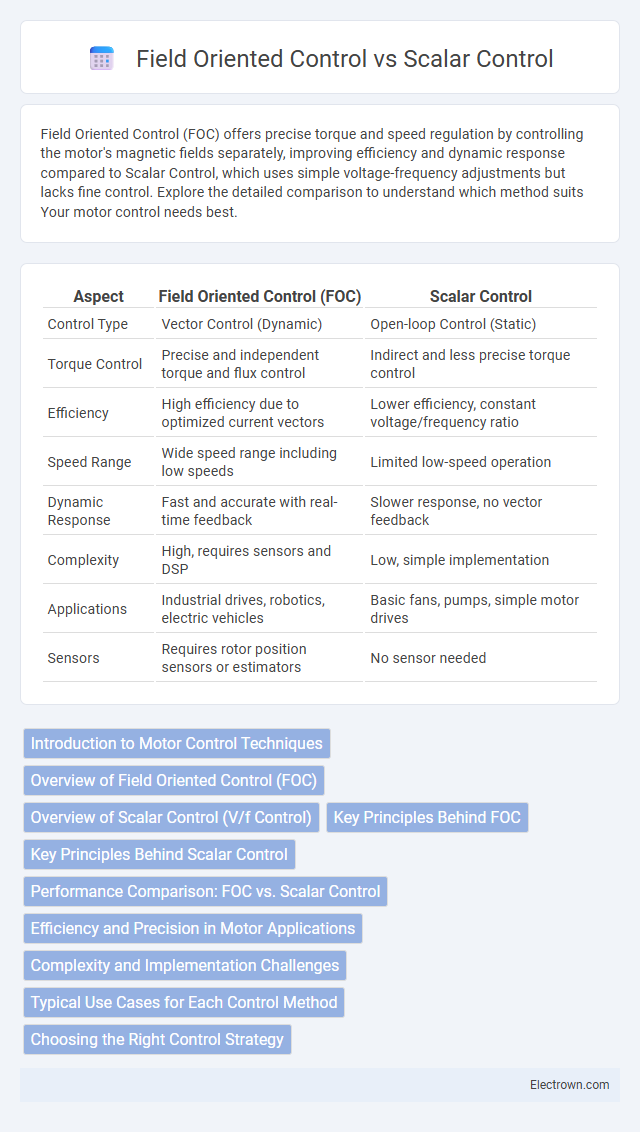Field Oriented Control (FOC) offers precise torque and speed regulation by controlling the motor's magnetic fields separately, improving efficiency and dynamic response compared to Scalar Control, which uses simple voltage-frequency adjustments but lacks fine control. Explore the detailed comparison to understand which method suits Your motor control needs best.
Table of Comparison
| Aspect | Field Oriented Control (FOC) | Scalar Control |
|---|---|---|
| Control Type | Vector Control (Dynamic) | Open-loop Control (Static) |
| Torque Control | Precise and independent torque and flux control | Indirect and less precise torque control |
| Efficiency | High efficiency due to optimized current vectors | Lower efficiency, constant voltage/frequency ratio |
| Speed Range | Wide speed range including low speeds | Limited low-speed operation |
| Dynamic Response | Fast and accurate with real-time feedback | Slower response, no vector feedback |
| Complexity | High, requires sensors and DSP | Low, simple implementation |
| Applications | Industrial drives, robotics, electric vehicles | Basic fans, pumps, simple motor drives |
| Sensors | Requires rotor position sensors or estimators | No sensor needed |
Introduction to Motor Control Techniques
Field Oriented Control (FOC) and Scalar Control represent two fundamental motor control techniques used in AC drives to optimize performance and efficiency. FOC enables precise control of torque and speed by independently managing the motor's magnetic flux and current components, resulting in superior dynamic response and energy efficiency. Scalar Control, based on direct voltage and frequency adjustment, offers simplicity but lacks the precision and responsiveness provided by vector control methods, making it suitable for less demanding applications.
Overview of Field Oriented Control (FOC)
Field Oriented Control (FOC) is an advanced motor control technique that precisely regulates the magnetic flux and torque of three-phase AC motors by transforming stator currents into a rotating reference frame. This method enables independent control of torque and flux, resulting in higher efficiency, improved dynamic response, and smoother operation compared to traditional Scalar Control. FOC is widely used in applications requiring precise speed and torque control, such as electric vehicles, robotics, and industrial automation systems.
Overview of Scalar Control (V/f Control)
Scalar Control, also known as V/f Control, regulates motor speed by maintaining a constant ratio between voltage (V) and frequency (f) applied to the motor. This method is simple, cost-effective, and widely used for applications requiring steady speed without precise torque control. Your motor performance benefits from straightforward implementation, but this approach lacks dynamic response and efficiency compared to Field Oriented Control.
Key Principles Behind FOC
Field Oriented Control (FOC) operates by decoupling torque and magnetic flux components in AC motors, enabling precise control of motor torque and speed through vector transformation techniques. By aligning the stator current vector with the rotor flux vector using a rotating reference frame, FOC achieves independent control of motor flux and torque, maximizing efficiency and dynamic performance. This method contrasts with Scalar Control, which regulates motor speed based on voltage and frequency without direct control over the magnetic field or torque, resulting in less precise motor response.
Key Principles Behind Scalar Control
Scalar control relies on adjusting voltage and frequency values to control motor speed without explicitly managing the magnetic field orientation. It uses simple V/f ratio control to maintain motor torque, making it cost-effective and easier to implement but less precise for dynamic performance. Scalar control is commonly applied in applications with steady speed requirements and low dynamic response demands, such as fans and pumps.
Performance Comparison: FOC vs. Scalar Control
Field Oriented Control (FOC) delivers superior dynamic response and higher efficiency compared to scalar control, enabling precise torque and speed regulation in AC motors. FOC achieves faster transient response and reduced torque ripple due to its vector control approach, while scalar control relies on voltage and frequency adjustment with slower reaction times. The enhanced performance of FOC makes it ideal for applications requiring high accuracy and energy efficiency, unlike scalar control which suits simpler, cost-sensitive scenarios.
Efficiency and Precision in Motor Applications
Field Oriented Control (FOC) offers superior efficiency and precision in motor applications by enabling dynamic control of torque and flux, resulting in optimized performance and reduced energy consumption. Scalar control, relying on fixed voltage-to-frequency ratios, delivers less precise speed regulation and lower efficiency, particularly under varying load conditions. The vector-based approach of FOC ensures faster response times and smoother operation, making it ideal for high-performance and energy-sensitive applications.
Complexity and Implementation Challenges
Field Oriented Control (FOC) involves complex mathematical transformations and requires precise rotor position feedback, making its implementation challenging compared to Scalar Control, which uses straightforward voltage-frequency relationships without the need for encoder feedback. The advanced algorithms in FOC demand higher computational power and real-time processing capabilities, increasing both the design complexity and cost. In contrast, Scalar Control offers simpler implementation with less computational burden but sacrifices dynamic performance and efficiency.
Typical Use Cases for Each Control Method
Field Oriented Control (FOC) is typically used in applications requiring precise torque and speed control such as electric vehicles, industrial robotics, and high-performance servo drives. Scalar Control is commonly applied in simpler, cost-sensitive systems like fans, pumps, and household appliances where precise torque control is not critical. FOC excels in dynamic and variable-speed environments, whereas Scalar Control suits steady-state, low-complexity motor applications.
Choosing the Right Control Strategy
Choosing the right control strategy between Field Oriented Control (FOC) and Scalar Control depends on your application's performance requirements and complexity. FOC offers precise torque and speed regulation ideal for high-performance and dynamic systems, while Scalar Control provides a simpler, cost-effective solution for less demanding applications. Evaluating factors such as response time, efficiency, and system cost will help determine the optimal approach for your motor control needs.
Field Oriented Control vs Scalar Control Infographic

 electrown.com
electrown.com